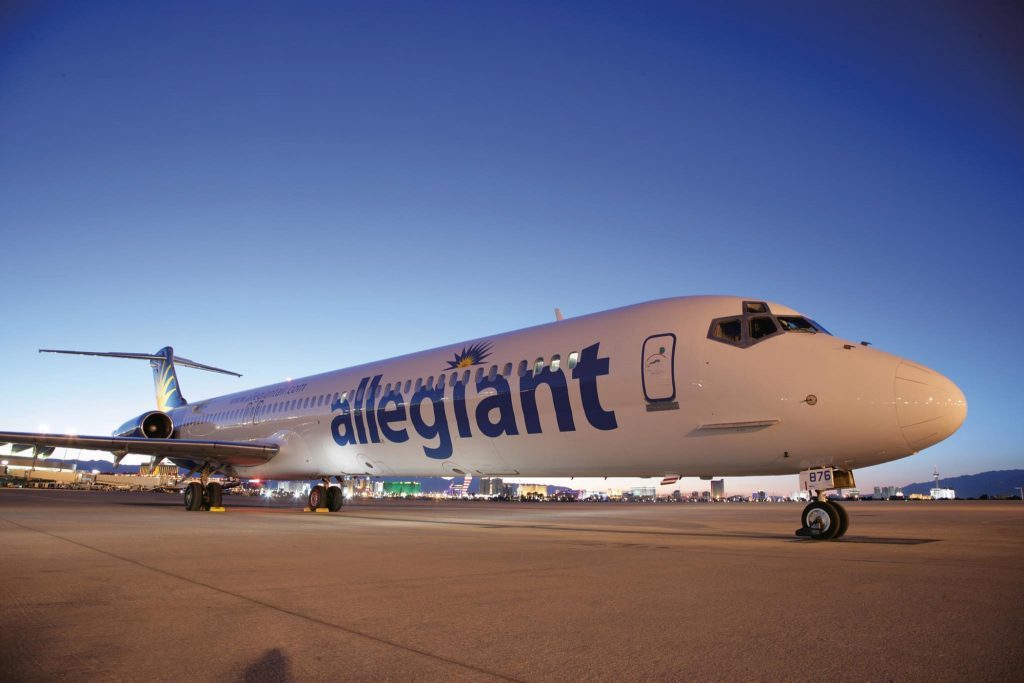Allegiant Air Agonizes Over New Routes for Months or Even Years

Skift Take
 Editor's note: This series, called Airline Insiders, introduces readers to behind-the-scenes decision-makers for airlines. Unlike our ongoing airline CEO series, Future of the Passenger Experience, we will not question the highest-ranking executives here. Instead, we will speak with insiders who guide decisions on airline operations, networks, marketing, and the passenger experience.
Editor's note: This series, called Airline Insiders, introduces readers to behind-the-scenes decision-makers for airlines. Unlike our ongoing airline CEO series, Future of the Passenger Experience, we will not question the highest-ranking executives here. Instead, we will speak with insiders who guide decisions on airline operations, networks, marketing, and the passenger experience.
Today, in the fourth installment of the series, we speak to an executive who chooses routes for Allegiant Air, one of the three ultra-low-cost carriers in the United States.
You can read all the stories in the series here.
There’s an old joke about airline planners — that they all have a world map tacked to their office walls. And when they need to launch a new route, they throw a dart at it. Wherever it lands is the airline's next destination.
It's not true, of course.
Planners take new routes seriously, often studying them for months – or even years — before recommending them. They examine as much information, from census data to migration patterns, as they can. They also look at how many passengers already fly between two cities, perhaps with a connection on another airline. And they might even look at road data to determine whether they can coax some travelers to fly rather than drive.
Kristen Schilling-Gonzales is director of planning at Allegiant Air, one of three ultra-low-cost-carriers, or ULCCs, in the United States. Allegiant has an usual model, preferring underserved routes from small and mid-size cities. One of its biggest markets is Punta Gorda, Florida, where it's the only airline. Its destinations from Punta Gorda include St. Cloud, Minnesota, Omaha, Plattsburgh, New York, and Belleville, Illinois.
We spoke with Schilling-Gonzales recently to learn how Allegiant chooses where to fly, and with what planes.
Note: This interview has been edited for length and clarity.
Skift: How do you describe your job?
Schilling-Gonzales: As director of planning, my primary goal and job is to decide the best use of our resources. That's anything from how we best use our aircraft to what routes we fly, to how often we fly them, to how we utilize our crews.
Skift: You've heard the joke about the dart board. Is it true?
Schilling-Gonzales: Have you been in on our meetings? Yeah, that's pretty accurate. I've heard the joke before. I also sometimes say it's more of a Wheel of Fortune-style wheel that we just spin and see what happens.
Skift: Nah. Really. Tell us how you pick new routes?
Schilling-Gonzales: We do put a little bit more focus into our routes. One thing we look at is [whether there is an] affinity [for travel] between two cities. Our marketing team is fantastic but one of the things that we haven't done as well is creating a market where people don't want to go already. We've done well with finding places people want to go and then offering them affordable options to do it nonstop.
Sometimes you can see [opportunity] in the existing traffic. Maybe there are other airlines that fly it either nonstop or connecting but their fares are really high. But sometimes you can't even see it with the existing traffic because people are just driving — because why would they want to spend several hundred or thousand dollars on a plane ticket for each person in the family when they can all just get in the minivan? We've succeeded on some routes by getting people off the roads and onto our planes. In those cases, it gets a little bit more difficult because it's harder to track drive traffic than it is people flying.
Skift: Do you look at any other data?
Schilling-Gonzales: We use a lot of census data. We also look at second-home ownership. We know that if you have a second home somewhere you're more likely to fly to it more often. We see that a lot in Florida and Phoenix but also up in Montana, with people going up from the L.A. Basin to a second home.
Skift: How much math is involved?
Schilling-Gonzales: We do a ton of it, trying to forecast what the profit and loss statement is going to look like for a new route. What we're going for in the end is, 'what's the best use [of an aircraft]? There's an opportunity cost to every route we run. How do we find out what's best? Maybe it is what's best in the next six or eight months but it's also what's best three to five years out. We can't just snap our fingers and have a market just come about. There's a lot of maturation that goes into it.
Skift: How long do you give a domestic route before you know whether it’ll work, or whether it should be canceled?
Schilling-Gonzales: We've probably somewhat famously had some routes that we've announced and then never actually flown. We don't try and do that, believe it or not. We try and give routes the benefit of the doubt [by] starting them in a season that makes the most sense. A ton of our traffic is in spring break and summer and winter holidays. By starting a new route in September, we're not usually giving it all of the oomph it needs. We're just not giving it a great chance. We try and start routes in certain seasons where we know there will be some peak demand.
We look at advance bookings and then every month we go through every route in our network, looking at how it has done — for that month, for the trailing 12 months, for that season compared to its peers.
Skift: Allegiant has three aircraft types — older MD80s, and newer Airbus A319s and A320s. All have a different number of seats, and different performance characteristics. Some can fly farther than others. Some burn less fuel. How do you decide the plane to use?
Schilling-Gonzales: This is funny to me because when I started at Allegiant, I didn't have an aircraft background by any means. I've [learned] more about different weight variances than I ever thought was possible.
Right now we're transitioning out of the MD-80 fleet, an older aircraft type. They hold 166 passengers. They don't have great takeoff performance, among other things. They don't like hot temperatures, and they don't like short runways. They don't like [high] altitudes so we've had to figure out which routes to fly those on where we can still use the plane well but don't have to take a fuel stop or reduce the number of passengers that we can allow onboard because of weight.
Skift: Are there places you'd like to send the MD80s because of the seat count, but can't because of performance issues?
Schilling-Gonzales: Yeah. Las Vegas in the summer. We've got very long runways but it's several thousand feet up and it gets hot. In the middle of the day, we know we can't send 166 passengers on that aircraft out to anywhere more than a couple hundred miles away. We either have to change our schedule to fit that or we have to change the aircraft type to fit that.
Skift: And the newer A319s and A320s handle heat and altitude without problems?
Schilling-Gonzales: Yes. That's why one of the many reasons that we've been transitioning into an Airbus fleet. We've got A319s and A320s and they hold anywhere from 156 passengers up to 186. We're excited looking at the future because it gives us the opportunity to do more almost on-demand dispatching. [Now] we extend the schedule six to nine months in advance [and say, ] this is the aircraft it's going to be forever. [In the future,] we can change it a lot closer in to a given flight.
Our 319s have 156 seats, and the 320s have 186. If it's a really peak weekend for a certain city, it might make sense to throw the extra seats on it that weekend versus a different weekend. Because the seat maps are so similar, it doesn't have quite as big of an impact on the customer.
Skift: Earlier this year, for the first time ever, Allegiant added new planes. They're Airbus A320s, and they should be more efficient than the used A320s already in the fleet. They can probably fly farther, too. Do you use the new ones on special routes?
Schilling-Gonzales: We ordered 12 new from the factory. I joke that they still have that new aircraft smell. It changes some of the things we can do but it doesn't really drastically change our network. We're still looking at unserved and underserved routes but it gives us an improvement in reliability.
Some of it is the new builds are overwater-equipped so that allows us to run some routes out to San Juan, Puerto Rico from the East Coast. Some of the older aircraft don't have that ability. The MD-80s certainly were a very limited fleet that could not have done those missions. So it's extended some things a bit but it hasn't changed our core business model as much as some people might say.
Skift: The new planes can fly from coast-to-coast of the United States. But you don't fly any transcontinental routes. Why not?
Schilling-Gonzales: [There are] basic concerns with coast-to-coast flights with a ULCC, [because] the network carriers have a ton of hubs throughout the country. If we wanted to fly something like Las Vegas or Los Angeles to Bangor, Maine, we've got the aircraft that can do it. But commercially it still might not make sense from a revenue perspective because if you're flying that, you could also stop in St. Louis, Chicago, Cincinnati, Philly, JFK, Charlotte, maybe even up to Detroit. There are so many different options for connecting flights that we would have to get such a premium on the non-stop.
We have looked into some longer flights from some places where maybe we've got some strength, and that are generally overlooked by other carriers. But generally, we don't overnight our crews or our aircraft. Everybody comes back to base every night, so we say all of our pilots and flight attendants are in their own bed each night. We're not paying for hotels, we're not paying per diem. We can better forecast what our maintenance plans are because the aircraft is coming home every night.
Some of the longer routes would require crew and aircraft overnights. Maybe we'll get there in the future.
Skift: We spoke to Air France-KLM's CEO several weeks ago, and he said sometimes network planners crunch the data, and the numbers say a flight is a sure money maker. And then once ticket sales start, it’s a loser. Does that ever happen to you?
Schilling-Gonzales: That happens. We've had some folks in the past who've told us if you're not failing, you're just not trying hard enough. We've gotten pretty comfortable with trying things and them not working. Sometimes everything just looks like, 'Oh man, this has got to be the next best route.' There's nobody flying it nonstop, and the one-stop or multi-connection fares are really high. We can definitely jump into this and make it work. Then it doesn't.
It's really frustrating because it's not like a math textbook. You can't just turn to the back and find out what the answer is and then work your way into it. You've got to look and see, what was the macro environment? What has changed? Why didn't it work? There's generally not a great answer. I don't want to say we're really familiar with it but we've had it happen several times.
Skift: Almost every small-and medium-size city wants to attract Allegiant. Many spend a fortune on consultants who create reports that tell you, and other airlines, how they’ll make big profits serving their city. Does the lobbying ever work? Or is the consultant data too skewed?
Schilling-Gonzales: I'm going to get roasted by consultants after this one. Let's see. OK. Use my words. We're generally focused on leisure customers. So when we talk to an airport and they talk about how this local hospital company or chain healthcare system in the area is opening up a new hospital and it's another 1,000 jobs, that's great. But those people aren't going to fly us for business, so we might not be quite so focused on it. But that is 1,000 more people with jobs, and those people will likely want to go on vacation. And we fly nonstop to vacation destinations, so it generally works out OK that way.
It's funny because we see a lot of cities and consultants who do their homework and know how to pitch it to us and then some that don't quite hit the mark. We do run into a lot of, 'Oh, well Allegiant in the past has always gone to small cities and we're a small city and Allegiant’s not here yet so they should be here because they're our only option.' I feel for a lot of the communities like that but from the airline perspective we've only got a limited fleet. We've only got limited crews. How do we make the most money for our shareholders and what's the best use of all these aircraft? It might not be every small Midwestern town. Maybe we have to focus on a couple of them.
Skift: I've heard you're tough negotiators with airports. Do you expect airports to waive fees, or provide revenue guarantees before you start service?
Schilling-Gonzales: We ask for incentives. There are some airlines that focus on revenue guarantees. We've done a few of them but if [a route] is not going to work long term we try not to get into those. [For] incentives, the FAA allows generally up to about two years of landing fee waivers and some other incentives. That really helps us with the start-up costs, offsetting the opportunity cost of adding another frequency on a well-performing route. [That gives us a chance] to try something new — maybe [the route] is the next best thing but it's just not at the top of our list yet because of some number of reasons. The incentives generally do help with that.
We also do a lot with marketing incentives because we're trying to find ways to get people to look at Allegiant.com. We're not on a [global distribution system], so how do you tell people to find you when maybe where they're used to looking wouldn't even have us up there?
Skift: For at least five years, Allegiant executives have — on and off — said the airline will fly internationally to Mexico and the Caribbean. Yet it hasn’t happened. What’s the update?
Schilling-Gonzales: It'd be so easy for me just to say, ‘Oh yeah, next year. It's going to happen next year.’ I honestly don't know the answer at this point. As a ULCC, we're used to building a lot of our own systems, and like I said we're not on a GDS. Our website is also part of our booking engine, and it's all internally created. [For] international, we're looking to build our own departure control system, [to] make sure we're sending all the right data to government agencies, all that stuff.
Skift: Do you already know where you'll fly when you get the OK?
Schilling-Gonzales: I've got a roughly five-year plan of several hundred routes that we could be running once international is up and going. The routes aren't the issue, it's the infrastructure and updating our systems to handle it.




